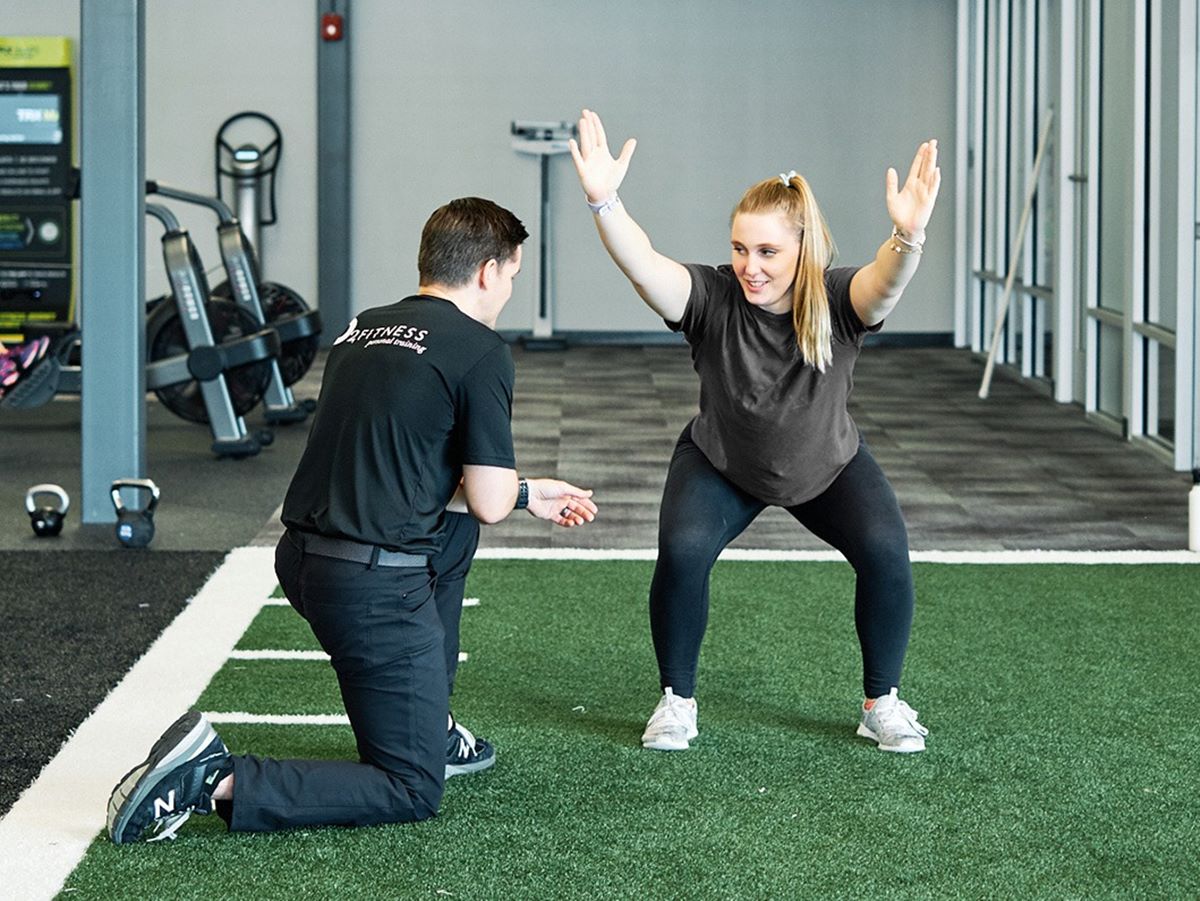

Featured
How To Exercise When Having Chronic Pain
Modified: January 2, 2024
Discover the best exercises for individuals with chronic pain in this featured guide. Find effective ways to stay active and manage pain.
Introduction
Living with chronic pain can be a challenging and exhausting experience. It affects not only your physical well-being but also your mental and emotional health. The constant pain can impact your daily activities, making it difficult to enjoy life to the fullest.
While it may be tempting to avoid physical activity altogether when experiencing chronic pain, research has shown that exercise can actually be beneficial in managing and reducing pain. Engaging in regular exercise not only helps to improve your overall physical fitness, but it can also help to alleviate some of the symptoms associated with chronic pain.
This article aims to shed light on the importance of exercise for individuals with chronic pain and provide practical tips on how to exercise safely and effectively. Whether you’re dealing with chronic back pain, arthritis, fibromyalgia, or any other type of chronic pain condition, this article will offer insights on how to incorporate exercise into your routine to find relief and improve your quality of life.
It’s important to note that before starting any exercise program, you should consult with your healthcare professional or a qualified physical therapist. They will be able to give you personalized advice based on your specific condition.
Now, let’s dive into the world of exercise and discover how it can help you manage chronic pain and regain control of your life.
Understanding Chronic Pain
Chronic pain is defined as any type of persistent pain that lasts for more than three months, even after the initial injury or illness has healed. Unlike acute pain, which serves as a warning sign for the body, chronic pain is often complex and can be caused by various factors.
One of the main characteristics of chronic pain is its impact on the nervous system. It can result from an injury, medical condition, or may have no clear cause at all. Common conditions that can lead to chronic pain include arthritis, fibromyalgia, migraines, neuropathy, and back pain.
Chronic pain can affect individuals differently, both physically and emotionally. It can cause physical limitations, decrease mobility, and disrupt everyday tasks. It can also lead to frustration, stress, anxiety, and depression.
It’s important to understand that chronic pain is a complex condition that involves not only the physical aspect but also psychological and social factors. The pain experience can vary from person to person, and what works for one individual may not work for another.
Some common symptoms of chronic pain include:
- Continuous or intermittent pain
- Aching or throbbing sensation
- Sensitivity to touch
- Muscle stiffness
- Fatigue or low energy
- Sleep disturbances
Managing chronic pain requires a comprehensive approach that takes into account the unique needs and circumstances of each individual. While medical interventions such as medications, injections, or surgeries may be necessary, there is growing evidence that non-pharmacological treatments, such as exercise, can play a crucial role in pain management.
Next, let’s explore the importance of exercise in managing chronic pain and how it can provide relief from the debilitating symptoms.
Importance of Exercise in Managing Chronic Pain
When faced with chronic pain, the idea of engaging in physical activity might seem counterintuitive. However, research has consistently shown that exercise can be a powerful tool in managing and reducing chronic pain.
Regular exercise can help to improve strength, flexibility, and endurance, which are crucial components in managing chronic pain conditions. It can also enhance your overall physical fitness, leading to improved quality of life.
Here are some key reasons why exercise is important in managing chronic pain:
- Pain reduction: Exercise has been shown to stimulate the production of endorphins, which are natural pain-relieving chemicals in the body. This can help to reduce the intensity of pain experienced by individuals with chronic pain conditions.
- Improved physical function: Chronic pain can often result in physical limitations and decreased mobility. Regular exercise can help to improve strength, flexibility, and range of motion, making it easier to perform daily activities and reducing the risk of further injury.
- Enhanced mood and mental well-being: Chronic pain can take a toll on your mental and emotional health. Engaging in regular exercise can boost the production of neurotransmitters, such as serotonin and dopamine, which are known to improve mood and reduce feelings of anxiety and depression.
- Weight management: Chronic pain conditions can sometimes lead to weight gain or difficulty in maintaining a healthy weight. Exercise can help to regulate weight by increasing calorie expenditure and promoting a healthy metabolism.
- Improved sleep: Many individuals with chronic pain struggle with sleep disturbances. Regular exercise can help to regulate sleep patterns and promote better quality sleep, leading to increased energy levels and improved overall well-being.
It’s important to note that when starting an exercise program for chronic pain management, it’s crucial to start slowly and gradually increase the intensity and duration of exercise. Working with a healthcare professional or a qualified physical therapist can help ensure that you’re engaging in exercises that are safe and appropriate for your specific condition.
In the next section, we’ll provide some practical tips for exercising with chronic pain to help you get started on your journey towards pain relief and improved well-being.
Tips for Exercising with Chronic Pain
Exercising with chronic pain requires a tailored approach that takes into consideration your individual needs and limitations. Here are some helpful tips to keep in mind when incorporating exercise into your routine:
- Consult with a healthcare professional: Before starting any exercise program, it’s important to consult with your healthcare professional or a qualified physical therapist. They can assess your condition, provide personalized advice, and recommend specific exercises that will be safe and effective for your situation.
- Start slow and gradually increase intensity: It’s essential to start with low-impact exercises and gradually increase the intensity over time. This allows your body to adapt and avoids exacerbating your pain or causing further injuries. Listen to your body and adjust the intensity based on your comfort level.
- Focus on flexibility and gentle stretching: Flexibility exercises can help to reduce muscle stiffness and improve range of motion. Incorporate stretching movements into your routine to improve flexibility and reduce the risk of muscle imbalances and joint stiffness.
- Choose low-impact exercises: Opt for exercises that minimize stress on your joints and muscles. Examples include swimming, water aerobics, stationary biking, and yoga. These activities provide cardiovascular benefits and help to build strength without putting excessive strain on your body.
- Listen to your body: Pay attention to how your body feels during and after exercise. If you experience an increase in pain that lasts for several hours or more, you may need to modify the intensity or type of exercise. It’s important to find a balance between challenging yourself and respecting your body’s limitations.
- Include rest days: Your body needs time to recover and heal. Incorporate rest days into your exercise schedule to allow your muscles and joints to relax and rejuvenate. Rest days are just as important as active days in managing chronic pain.
- Use proper form and technique: When performing exercises, it’s crucial to use proper form and technique to avoid unnecessary strain on your body. If you’re unsure about the correct form, consider working with a qualified fitness professional or physical therapist for guidance.
- Stay hydrated: Drink plenty of water before, during, and after exercise to stay properly hydrated. Dehydration can contribute to muscle cramps and other discomforts, so make sure to maintain adequate fluid intake.
- Be patient and persistent: It’s important to remember that managing chronic pain through exercise takes time and consistency. Results may not be immediate, but with patience and persistence, you can gradually experience the benefits of regular physical activity.
Remember, everyone’s journey with chronic pain is unique, and it’s essential to find an exercise routine that works best for you. Don’t be afraid to experiment with different types of exercises and listen to your body’s feedback to determine what feels most comfortable and effective for managing your chronic pain.
In the next section, we’ll explore different types of exercises that can provide relief for chronic pain.
Types of Exercise for Chronic Pain Relief
When it comes to managing chronic pain, incorporating the right types of exercise can make a significant difference in relieving symptoms and improving overall well-being. Here are several types of exercises that have shown to be beneficial for individuals with chronic pain:
- Aerobic exercises: Aerobic exercises, also known as cardiovascular exercises, help to improve heart and lung function while increasing overall endurance. Low-impact activities such as walking, swimming, cycling, and water aerobics can be particularly beneficial for chronic pain management as they minimize stress on the joints and muscles.
- Strength training: Strengthening exercises are essential for supporting the muscles and joints, which can help alleviate some of the stress and strain caused by chronic pain conditions. Focus on exercises targeting major muscle groups, such as squats, lunges, and resistance band exercises. Start with lighter weights or resistance and gradually increase as your strength improves.
- Flexibility and stretching exercises: Stretching exercises help to improve joint flexibility, reduce muscle stiffness, and increase range of motion. Incorporate gentle stretching exercises into your routine, such as yoga, tai chi, or Pilates. These activities can enhance flexibility, promote relaxation, and improve overall physical function.
- Stability and balance exercises: Improving stability and balance is crucial for individuals with chronic pain as it can help prevent falls and injuries. Exercises such as yoga, tai chi, and balance board exercises can improve proprioception and enhance stability, reducing the risk of accidents.
- Water-based exercises: Exercising in water provides natural resistance and buoyancy, which can be highly beneficial for individuals with chronic pain. Water aerobics, swimming, and aquatic therapy can help improve cardiovascular fitness, increase strength, and reduce joint impact.
- Mind-body exercises: Mind-body exercises, such as meditation, deep breathing, and mindfulness practices, can be valuable for individuals managing chronic pain. These techniques help to reduce stress, induce relaxation, and promote a sense of well-being, which can positively impact pain levels.
Remember, it’s important to choose exercises that are appropriate for your specific condition and level of comfort. Start with low-impact activities and gradually progress as your pain tolerance and physical fitness improve. It’s always recommended to consult with a healthcare professional or a qualified physical therapist to ensure you’re engaging in exercises that are safe and effective for your unique situation.
In the next section, we’ll discuss some precautions and safety measures to keep in mind when exercising with chronic pain.
Precautions and Safety Measures
When exercising with chronic pain, it’s important to take certain precautions and follow safety measures to minimize the risk of further injury or exacerbating your pain. Here are some key considerations to keep in mind:
- Consult with a healthcare professional: Before starting any exercise program, seek guidance from your healthcare professional or a qualified physical therapist. They can provide specific recommendations based on your condition and help you create an exercise plan that is safe and effective.
- Start slowly and gradually progress: Begin with low-intensity exercises and gradually increase the duration and intensity over time. Avoid pushing yourself too hard too soon, as it can lead to increased pain or injury.
- Listen to your body: Pay attention to your body’s signals during exercise. If you experience increased pain or discomfort that lasts for an extended period, modify the exercise or consult with your healthcare professional.
- Warm-up and cool down: Always start your exercise session with a gentle warm-up to increase blood flow to your muscles and prepare them for activity. Similarly, finish your workout with a cool-down period to gradually return your heart rate to normal and prevent muscle soreness.
- Proper form and technique: Use correct form and technique during exercises to minimize the risk of injury. If you’re unsure about proper form, consider working with a qualified fitness professional or physical therapist for guidance.
- Modify exercises as needed: It’s important to modify exercises to suit your abilities and limitations. If a certain movement or position exacerbates your pain, find alternative exercises or modify the range of motion to avoid discomfort.
- Hydrate adequately: Drink plenty of water before, during, and after exercise to stay hydrated and prevent muscle cramps or fatigue. Dehydration can worsen pain symptoms, so it’s crucial to maintain proper fluid intake.
- Take rest days: Allow your body time to rest and recover between exercise sessions. Incorporate rest days into your routine to prevent overexertion and reduce the risk of injury.
- Use appropriate equipment: Ensure that you have the necessary equipment and supportive gear for your chosen exercises. For example, wear comfortable and supportive shoes for walking or invest in proper yoga props for yoga practice.
Remember, every individual’s pain tolerance and abilities are different. It’s crucial to listen to your body and respect your limits. If you experience severe pain or persistent discomfort during or after exercise, consult with your healthcare professional to reassess your exercise plan.
Now that we’ve covered precautions and safety measures, let’s move on to a sample exercise routine that can help relieve chronic pain.
Sample Exercise Routine for Chronic Pain Relief
When creating an exercise routine for chronic pain relief, it’s important to focus on low-impact activities that target specific areas of your body and promote flexibility, strength, and relaxation. Keep in mind that this is a sample routine and should be modified to meet your individual needs and limitations.
Warm-up:
- Start with five minutes of gentle walking or stationary cycling to warm up your muscles and increase blood flow.
- Perform light stretches for major muscle groups, focusing on areas that commonly experience pain or stiffness.
Cardiovascular exercise:
- Engage in 20-30 minutes of low-impact aerobic exercise, such as brisk walking, swimming, or using an elliptical machine.
- Choose activities that you enjoy and that won’t place excessive stress on your joints.
Strength exercises:
- Perform two to three sets of 10-15 repetitions of strength exercises targeting different muscle groups.
- Examples include squats, lunges, bicep curls, tricep extensions, and seated rows using resistance bands or light dumbbells.
- Start with lower weights or resistance and gradually increase as your strength improves.
Flexibility exercises:
- Incorporate gentle stretching exercises for flexibility and range of motion after your strength exercises or as a separate session.
- Focus on stretching major muscle groups, as well as specific areas of chronic pain or tightness.
- Consider practicing yoga or tai chi, which can provide both stretching and relaxation benefits.
Stability and balance exercises:
- Include exercises that improve stability and balance, such as yoga poses, balance board exercises, or single-leg balance exercises.
- Work on improving your balance gradually and within your comfort level, using support if needed.
Cool-down and relaxation:
- Finish your exercise routine with five to ten minutes of gentle walking or slow cycling to cool down and gradually lower your heart rate.
- Engage in relaxation techniques such as deep breathing, meditation, or mindfulness exercises to promote relaxation and reduce stress.
Remember to listen to your body and modify the routine as needed. If any exercise or movement causes increased pain or discomfort, stop and consult with your healthcare professional or physical therapist for guidance.
Always aim for consistency rather than intensity. It’s better to do low-impact exercises regularly than to push yourself too hard and risk exacerbating your pain. Adjust the duration and intensity of each exercise according to your comfort level and gradually increase as your tolerance improves.
Now that you have a sample exercise routine, you can customize it based on your preferences and consult with a healthcare professional to ensure it suits your specific needs.
Conclusion
Living with chronic pain can be incredibly challenging, but incorporating regular exercise into your routine can be a game-changer in managing and reducing pain symptoms. Exercise not only helps to improve physical fitness but also provides numerous benefits for mental and emotional well-being.
Understanding your chronic pain condition and its impact on your body is crucial for selecting appropriate exercises. Low-impact activities such as aerobic exercises, strength training, flexibility exercises, stability, and balance exercises, and mind-body exercises can all contribute to pain relief and overall improvement in function.
When exercising with chronic pain, it’s important to take precautions and follow safety measures to avoid injury or exacerbating your pain. Consulting with a healthcare professional or physical therapist and starting slowly with gradual progression will help you develop a routine that suits your needs and limitations.
Remember, each person’s pain experience is unique, and there is no one-size-fits-all approach. It’s essential to listen to your body, respect your limits, and make modifications as needed. Patience and persistence are key in managing chronic pain through exercise.
By incorporating exercise into your lifestyle and following a well-rounded exercise routine, you can experience reductions in pain, improvements in physical function, better mood, and enhanced overall quality of life.
If you’re unsure about where to start or need guidance, don’t hesitate to seek support from healthcare professionals, physical therapists, or fitness experts who can provide personalized advice.
Remember, you’re not alone in your journey toward chronic pain management. With the right approach, mindset, and commitment, you can regain control of your life and find relief through the power of exercise.









